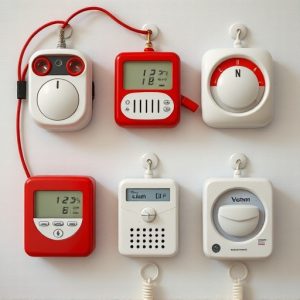Discrete Wearable Alarms: Securing Personal Safety on College Campuses
Personal Safety Devices (PSDs) for college students are becoming vital in today's digital age,…….
Personal Safety Devices (PSDs) for college students are becoming vital in today's digital age, addressing growing campus security concerns. Wearable alarms, like bracelets or pendents, offer discreet yet powerful protection. These devices empower students to navigate labyrinthine campuses safely, enhancing existing security measures. PSDs include compact alarm devices, GPS trackers, and emergency buttons integrated into stylish accessories, providing peace of mind for independent students. To maximize benefits, choose a stylish design, keep batteries charged, practice alarm usage, and pair with safety apps for rapid communication. Effective use depends on consistency and awareness.
“In today’s digital age, personal safety is a paramount concern, especially on bustling college campuses. As students navigate labyrinthine paths between classes and activities, introducing discrete wearable security alarm systems could be a game-changer. This article explores the growing need for such innovations in higher education, delving into various types of personal safety devices available. We weigh the advantages against potential challenges and offer practical tips for integrating these powerful tools seamlessly into students’ daily lives.”
- Understanding the Need for Wearable Security Alarms on College Campuses
- Types of Discrete Personal Safety Devices
- Advantages and Potential Challenges
- Integrating Wearable Alarms into Daily Life: Tips and Best Practices
Understanding the Need for Wearable Security Alarms on College Campuses
In today’s digital era, personal safety devices for college students have become increasingly vital on campus. With rising concerns about security and an abundance of personal belongings, wearable security alarm systems offer a discrete yet powerful solution. These innovative devices empower students to protect themselves while navigating the bustling college environment. By integrating alarm functionality into accessible and discreet forms, such as bracelets or pendents, students can quickly and quietly alert others in case of emergencies.
College campuses, with their labyrinthine paths and diverse populations, present unique challenges for personal safety. Wearable alarms provide a hands-free approach to security, ensuring that students remain vigilant without constant concern. This technology complements existing campus security measures, fostering a safer environment where folks can focus on their studies and extracurriculars without the added burden of constant vigilance.
Types of Discrete Personal Safety Devices
Personal Safety Devices for College students come in various forms, each designed to offer discrete protection and peace of mind. One popular option is personal alarm devices, often worn as a pendant or bracelet, that emit a loud shrieking sound upon activation, deterring potential attackers. These devices are compact, easy to operate, and can be carried discreetly, making them ideal for students navigating campus alone at night.
Beyond alarms, other discrete personal safety tools include GPS trackers and emergency buttons integrated into stylish accessories like bags or wallets. Some even feature automatic fall detection for added peace of mind. These innovations empower college students to feel safer while exploring their new surroundings, providing an extra layer of security during their formative years.
Advantages and Potential Challenges
Advantages and Potential Challenges
Discrete wearable security alarm systems offer a significant boost to personal safety, especially in environments like college campuses where individuals are often on their own or in unfamiliar settings. These devices provide a sense of security by allowing users to discreetly alert others or authorities in case of distress. Moreover, they empower students to navigate their surroundings with added confidence, knowing that help is readily available should any potential hazards arise.
Despite their numerous benefits, there are challenges to consider. Privacy concerns top the list, as users must trust that these devices respect their personal data and only activate alarms when necessary. Additionally, ensuring reliable connectivity across vast campuses and varying signal strengths is crucial for effective deployment. Yet, with careful design and adherence to privacy standards, these wearable security alarm systems hold great promise in enhancing Personal Safety Devices for College students.
Integrating Wearable Alarms into Daily Life: Tips and Best Practices
Integrating wearable alarms into daily life offers a new level of personal safety, especially for college students navigating unfamiliar environments. These discrete devices provide peace of mind and an added layer of protection. To maximize their benefits, consider a few best practices. Firstly, choose a stylish design that complements your wardrobe; many modern wearables offer sleek profiles and customizable options to blend seamlessly with your look. Secondly, ensure easy accessibility—wear them on a wrist or in a pocket for quick activation when needed.
For optimal functionality, keep the battery charged and familiarize yourself with the alarm’s features. Practice setting and testing alarms regularly, ensuring you understand the triggers and alerts. Additionally, consider pairing your wearable with personal safety apps that offer emergency communication features, allowing for rapid response during emergencies. Remember, these devices are tools to enhance your sense of security; their effectiveness relies on consistent use and awareness.
Discrete wearable security alarm systems offer a promising solution for enhancing personal safety on college campuses. By integrating these innovative devices into daily life, students can gain peace of mind and empower themselves against potential threats. When choosing the right Personal Safety Devices for College, understanding the various types, their advantages, and addressing challenges will ensure maximum effectiveness. Following best practices for integration encourages a safer environment, fostering security and confidence among students.


